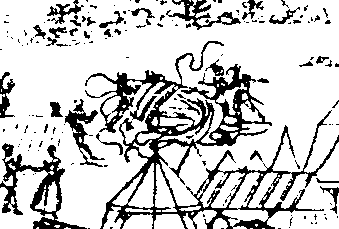

In the beginning was the center pole ... at least that's the most basic pole structure imaginable, consisting of a single piece. Drape a piece of cloth over it and you have a basic shelter. Eventually, somebody realized that the most efficient use of cloth would be to sew a cone (or at least a slotted circle, or circular section, that could be formed into a cone)). Such a tent didn't need guy ropes, although the taller and more slender ones probably could have used "wind lines" to keep in stable in storms.
The cone is a highly efficient structure for a number of reasons: it has great stability, uses no guy ropes, and sheds weather well. For even greater stability, you could replace the center pole with a tripod or quadropod of poles. Add more poles, and you eventually end up with a tipi, probably the best of nomadic structures. (But, strictly speaking, it wouldn't be a tent anymore, if you define a tent as a "tension structure" where the cloth assumes much of the structural load. By that definition, yurts aren't tents, either, but since the walls are cloth, we find it convenient to lump them all in with tension structures.)
One trouble with cone structures is that they don't make good use of perimeter space ... you can store stuff on the floor space next to the wall, but you can't stand up there. If you're trying to maximize the use of useable space and minimize the use of cloth, the next step would be to keep the upper part of a cone as a roof, but keep it outstretched with ropes and have the walls hang more or less straight down from the eave of the roof. The result is the sort of round tents we see in early period depictions (10th Century or so).
There's one tentmaker that insists that this was all the structure that was ever used ... no rings or side poles to support the eave of the roof, only the tension on the guy lines themselves. It's hard to counter this argument when all you've got are period depictions, because period artists usually didn't pay attention to such detail. (Many artists didn't even draw the center pole, leading some reconstructionists to posit that the center pole was eliminated and replaced with side poles supporting other roof-bracing structures.) Christine Robertson, who has done a fair amount of research on the subject, calls these tents with "no visible means of support.")
Ms. Robertson believes that rings were used, and points for evidence to a period depiction of a storm blowing down tents in an encampment. A couple of these tents are shown lying on the ground, but still have their eaves supported somehow. (See figure 1)
 |
Figure 1. A detail of an 18th C. engraving of a 16th c. painting of Henry VIII's encampment at Marquison, France in 1544. The original is no longer in existence. |
|---|
Coryn Weigle, who makes tents for Medieval Miscellany, also believes that tents used rings, which she says were made on the spot from bent saplings. As evidence, she cites a letter written by a merchant guild to a town. The guild was no longer going to patronize the town's fairs, the letter said, because there was getting to be a scarcity of available saplings in the area and the merchants weren't happy about bring in their own.
The only problem with this is that merchants didn't use round tents, to the best of my knowledge. They used the saplings for booths of a different design entirely (see figure 2)). These booths were essentially semi-cylindrical structures, like a cloth Quonset hut, with the display area on one end and probably a private entrance in the back. The saplings were undoubtedly used to form the ribs of the structure.
 |
Figure 2. A period depiction of merchant's booths (from the Bibliotheque Nationale, Paris) |
|---|
 |
Another detail of the scene in figure 1. This suggests that at least some of the round tents in the picture had a type of eave bracing. |
|---|
For another thing, the steeper the ropes are, the less likely somebody is to trip on them. That was as much of an advantage in period as it is today ... even more, perhaps, since; the lighting wasn't as good as ours is today.
Of all the bracing structures, the ring is probably the simplest, lightest, and easiest to set up. That's why Dragonwing uses it for our round pavilions, although I make no claim for authenticity. I have also seen various kinds of spoke-based designs, either radiating out from the center pole or using a "wagon wheel" affair sitting on lots of side poles, with a false centerpole protruding from the wheel's axle and supporting the canopy peak. There doesn't seem to be any documentation for any of these designs, only a sentiment that they would have been within the technology of the period and would have been logical outgrowths of that technology.
Before leaving this subject altogether, it's worth mentioning that Christine Robertson suspects that many of the pavilions in period pictures aren't tension structures at all, but fabric (and sometimes paneling) attached to rigid frames. I think she may be right about this. Certainly the tent in the famous Froissart picture (figure 4) stands suspiciously well without guy ropes, and a rigid frame would have made those dormer windows a lot easier to support.
 |
Figure 4. From Froissart's Chronicles. Note not only the absence of guy ropes, but what looks like some sort of internal structure (or at least a helluva lot of side poles) in the tent itself. |
|---|